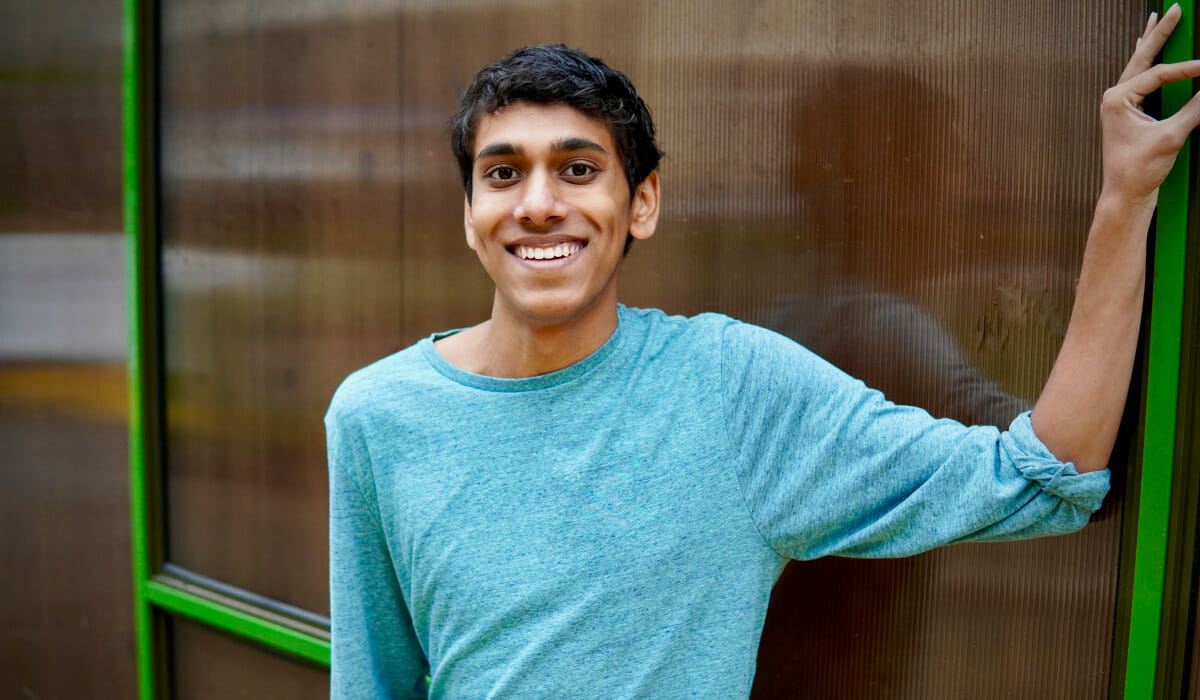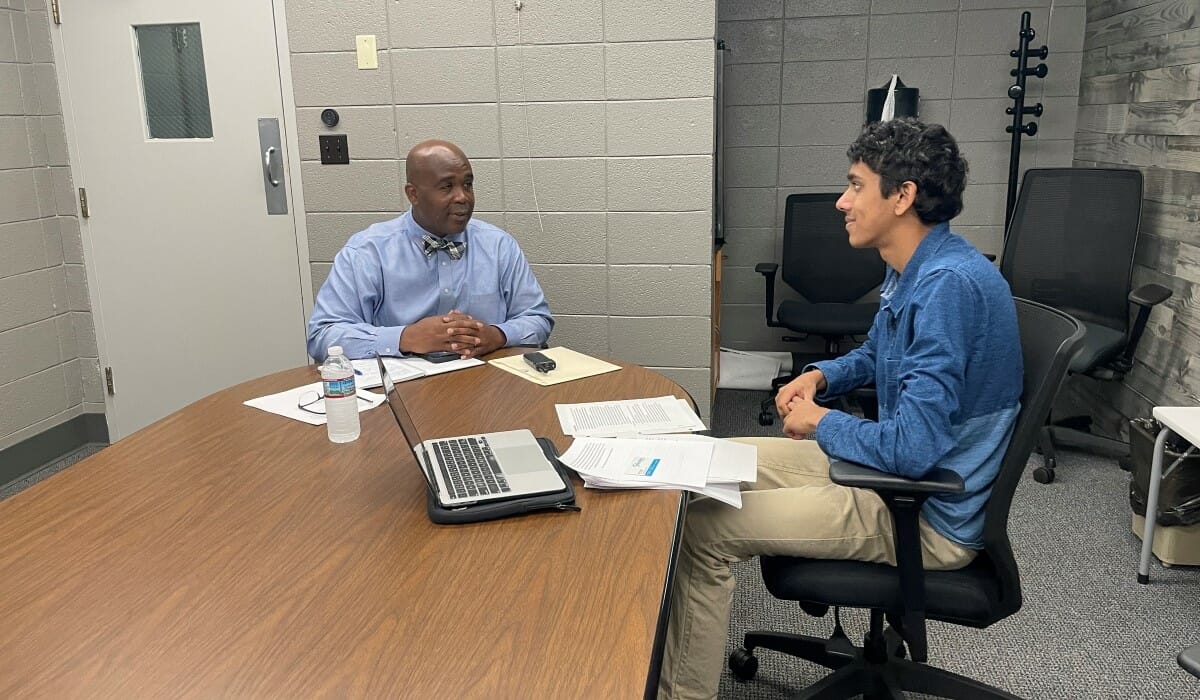From a Science Fair Discovery to Working for Healthcare Equality for All

Meet Daily Point of Light Award honoree Cam Srivastava. Read his story and nominate an outstanding volunteer or family as a Daily Point of Light.
Cam Srivastava did not expect a ninth grade science fair project to change his life. Cam’s family has a history of severe heart disease. His grandfather couldn’t walk without gasping for air, and he needed heart surgery but was too frail for it. For his science fair project, Cam learned about a new heart procedure, TAVR or Transcatheter Aortic Valve Replacement which is a non-surgical option for patients like Cam’s grandfather.
Cam’s initial aim was to examine risk factors associated with heart valve disease, but he quickly discovered an unexpected and shocking finding: whether patients received TAVR at the local hospital or not depended on their race. This disparity in access offended Cam’s sense of fairness and equity. Cam made it his mission to ensure that all patients receive equitable treatment by the healthcare system, founding an organization called Equity Starts from the Heart.
What inspires you to volunteer?
I realized that through no fault of their own, people of color weren’t getting the healthcare they needed. This inspired me to make healthcare more equitable and accessible to all. Behind each data point on a chart or graph is a person with a family who deserves to be treated fairly!
To examine the reasons for BIPOC people not having access to certain procedures, we conducted biostatistical analysis on deidentified patient data from the local hospital, Spartanburg Medical Center (SMC). We analyzed a patient population at SMC who received a novel treatment, TAVR, for one of the most common heart diseases, aortic stenosis, and found that 9.7% of the patients treated with TAVR in Spartanburg, Laurens, Union and Cherokee counties (those whose nearest TAVR option is SMC) were Black, and that 89.7% were white. This is in stark contrast to the racial demographics of 73.5% white and 22.1% Black of those four counties. Black patients are not represented in the TAVR patient population in accordance with the community demographics, despite having equal or higher levels of risk for needing the procedure.
Additionally, we distributed a survey to more than 200 community members at barber shops, churches, community centers and schools. The results of the study indicate that the Black population on average does not have the same distribution of “advantages” that the TAVR patient population has — access to insurance, primary care physicians or average household value (marker of socioeconomic status) — which could be a factor for why they are not represented equitably. Another factor for why they are not represented equitably could be implicit bias, which has been well documented in broader studies of healthcare systems throughout the United States. However, the data does indicate a similar outlook in the disadvantages between the TAVR patient population and the black population — risk factors such as high cholesterol and high blood pressure.
Describe your volunteer role with Equity Starts from the Heart.
My role as founder of “Equity Starts from the Heart” is to raise awareness of disparities in heart healthcare and broaden access to innovative treatments. I have created a coalition of community members, physicians, nurses, hospital leaders, pastors, politicians and educational institutions to attack the problem together. I regularly go to Black churches and other community centers, explaining my findings to pastors and making presentations on the newest treatments and offering free screenings to their congregants.
What’s been the most rewarding part of your work?
I met an elderly BIPOC woman who said she had been diagnosed with a heart murmur, but her primary care physician had taken no follow up action; thus, she had no conception of her situation’s severity. Her example of no follow up action and no referral to a specialist is significant because it illustrates the implicit bias exhibited by physicians in the healthcare system. There have been many studies documenting implicit bias in healthcare.
I encouraged her to ask her doctor questions, and she ended up needing TAVR. Her family told her pastor that my presentation helped save her life. I was humbled and impacted by the power of advocacy and continued my work through informing hospital administrators of my findings. “Equity Starts from the Heart” has allowed me to broaden access to this new heart procedure for the marginalized in my community and revealed that research and medical advancement are most impactful when they bring widespread benefit to all.

What have you learned through your experiences as a volunteer?
Healthcare professionals did not know that these healthcare inequality issues existed. Once I explained my findings to them, they were willing to help and wanted to do their part to improve access to healthcare.
Furthermore, I’ve learned that BIPOC members of the community are not looking for handouts or abstract advice; they are looking for practical advice such as what to ask their doctors, procedures to inquire about, and so on. They also need someone to take an interest in their lives and actively advocate for healthcare accessibility for all.
Are there any future partnerships, programs or events that you are excited about?
Heart disease is a rampant problem in the southeastern United States, so I hope to continue improving access to heart care throughout the region. I want to extend my current project to partner with outreach organizations including the American Heart Association and others throughout my local community and beyond South Carolina. I am now focused on talking to hospital systems outside of South Carolina and sharing my findings and experiences with them. Equity Starts from the Heart is responsible for organizing free heart screenings and presentations at community centers.
Why is it important for others to get involved with causes they care about?
To strengthen community bonds and truly act as each other’s keepers, we must get involved and realize that a community is only as strong as people helping each other. Each of us has an area of life that we’re passionate about, where we might notice a need. This is a good opportunity to make a difference!
What do you want people to learn from your story?
My story should tell people the power of getting involved and being willing to speak up. Discovery can take you on unexpected paths, and asking questions is only the start in making a difference. After you ask questions, you may find a problem or need in the community. Then comes the “hard” part. Instead of just sitting on what you have found, you need to take action and come up with a plan of how to alleviate the issue, even though that may be an arduous process.
As John Lewis said, “when you see something that is not right, not fair, not just, you have a moral obligation to continue to speak up, to speak out.” I try to embody that mindset in all areas of my life and would encourage others to always be inquiring and willing to take that next step beyond mere identification of a problem.
Do you want to make a difference in your community like Cam? Find local volunteer opportunities.
